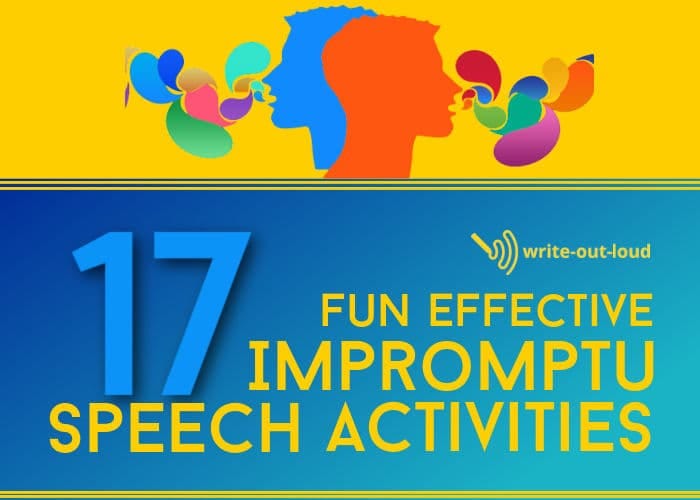Speed speaking - quickfire speechifying
An impromptu speech activity to build confidence and skills
Maybe you heard of speed dating? Yes? What about speed speaking?
Let me introduce you. It’s noisy. It’s fast, a whole lot of fun and a great way to get groups of people (classes) talking, making mini speeches, without fear.
Here’s how speed speaking goes.
Allow 30 - 40 minutes to run the activity all the way through.
Make a copy of this Speaking Topic sheet for each person.
Seat your students in two circles – an inner and outer circle facing each other.
Each person in the pair chooses a topic from the sheet to give the other to talk on for 1 minute. The person who chooses the topic times the speech.
When both speeches are completed. (Approximately 2 mins. 30 per pair.) Call ‘CHANGE’.
The students in the inner circle stay in their places. The ones in the outer circle move one place to the right. Everyone now has a new partner.
New topics are chosen, and new speeches made. Call ‘CHANGE’ when they’re through.
Repeat until you’ve been round the entire circle.
When I’ve used this activity, I’ve stressed I’m not looking for perfectly formed mini speeches. I don’t want people too scared to open their mouths. Instead, the goal is simply to speak on the topic - to string a couple, or more ideas together, or to tell a small story.
Getting started
If your class has never done this before, demonstrating will help them understand how it works.
Ask for 6 volunteers. 3 of them will represent the inner circle. Then ask the remaining 3 to pick a person and sit facing them. This is the outer circle.
Ask everyone to look at the topic sheet. Explain that the topics are open-ended trigger words, that will hopefully quickly fire off a bunch of ideas to speak on. There are no right or wrong answers for any of them. What one person says in response to ‘giggling’ or ‘stupid’ will most likely be completely different from another person’s answer.
Ask for a pair from your volunteers to show the activity to the class. The person sitting on the inner circle begins by choosing a word to give to their partner. For example: Purple.
That person speaks for 1 minute while their partner times them.
E.g. ‘Purple reminds me of the color of bruises. I got an absolutely huge one on my left leg last winter when I tripped and fell going down the stairs off the deck. They were icy and I sort of bounced from the top one all the way to the bottom. With each bounce I yelled a little louder and the bruise got a little bigger. Six of those gave me a patch work of deep purple from my thigh to my shin.’
When the minute is up, they swap over roles. The person who has just finished speaking chooses the topic and does the timing while other talks.
When that speech is done, call ‘CHANGE’. Each person in the outer circle moves one place to the right. Then the inner circle person chooses a topic and times while their partner speaks. Now you should have 3 of your volunteers speaking, while 3 time. Then they swap over … etc., etc.
That should be enough of a demonstration for everybody to know what they’re doing!
It’ll be loud. There’ll be laughing, and you’ll know it’s a winner when it’s asked for again and again.
Until next week, happy teaching,
Susan
For more see 17 fun impromptu activities.
PS. As I said last week, and I’ll say next, if you have ideas for topics you’d like to see covered in this newsletter, or if you’d like to share an article on some aspect of public speaking, or a speech of your own, please get in touch. Either reply to this email or contact me through the form on my about me page on my website. I’d love to hear from you!


